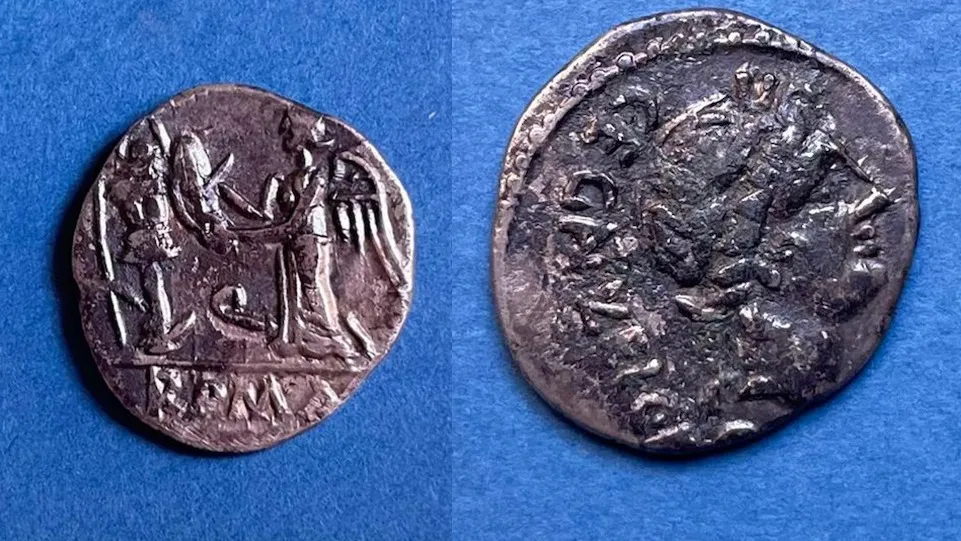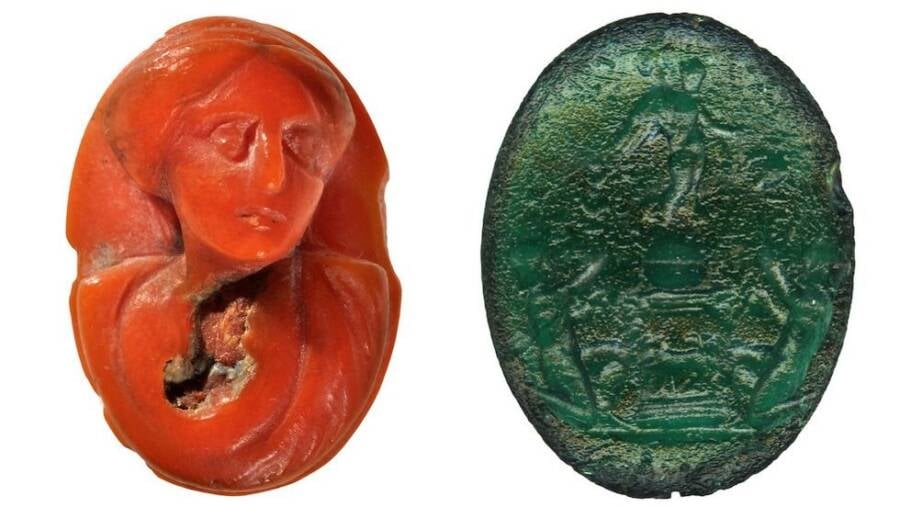Archaeologists discovered this treasure trove in the ruins of a theater in the ancient Roman city of Claterna, confirming that the site was once a major commerce center for Romans.

Soprintendenza BolognaArchaeologists discovered more than 3,000 Roman coins in the ancient city of Claterna.
While sifting through the remains of an ancient theater in northern Italy, archaeologists recently made an astonishing discovery: Buried in the ruins were thousands of Roman coins and colored gems.
Archaeologists uncovered this treasure trove during ongoing excavations of the Roman city of Claterna near modern-day Bologna. In addition to more than 3,000 silver and bronze coins, researchers also uncovered 50 colored gems adorned with depictions of ancient Roman deities and notable structures.
“We find ourselves in front of the largest non-stratified archaeological area in Northern Italy,” said Italian Undersecretary of State at the Ministry of Culture Lucia Borgonzoni in a translated statement. “Given the importance and quantity of finds brought to light so far, we can probably speak of a Pompeii of the North.”
One of the most notable discoveries among the coins and gems was a rare silver quinarius, minted in 97 B.C.E. by the Roman Republic. Such coins are “so scarce that many experienced collectors have never even seen one,” according to Coin Week. This discovery also helped researchers date the theater to the first century B.C.E.

Soprintendenza BolognaThe gems discovered at Claterna were emblazoned with figures of ancient Roman deities.
Only about a tenth of the city of Claterna has been excavated so far. Previous excavations have uncovered a forum, mosaics, streets, and bath houses.
Borgonzoni described the city of Claterna as “a jewel of inestimable value for the region and the country,” adding that the area will continue to be excavated.
“A large part of the area remains to be discovered,” added Superintendent of Bologna Francesca Tomba in the statement. “We can therefore plan a major phase of wide-ranging knowledge and valorization of a site that still has so much to tell — an area not compromised, given that we are in the countryside.”
At some point in the 2nd century B.C.E, Claterna emerged along the Via Aemilia, an ancient Roman road connecting northwest Italy and the Adriatic Coast. Many of the settlements along this road were strategically created as resting points for Roman legions and travelers.
However, the treasure trove discovered in the ancient theater, and particularly the rare quinarius, now suggest that Claterna was not simply a stopping point along the road but a “center of commerce with direct contacts with Rome,” according to the statement.
In recent years, there have been several similarly notable discoveries, including the discovery of nearly 50,000 ancient Roman coins off the coast of Sardinia, reported earlier this month. These kinds of finds can tell archaeologists and historians much about ancient societies and their economies.
Earlier this year, another hoard of coins was found buried in a small terracotta pot in Tuscany. This pot was likely hidden by a Roman soldier or a businessman, who tragically never returned for it.
“This treasure is about a person’s life, the savings of a soldier’s life, and his hopes for building his farm,” archaeologist Lorella Alderighi said at the time. “However, it also tells a sad story: The owner of the coins died before he could make his dreams come true using his savings. The coins tell his story.”
Another notable discovery was a hoard of valuable Roman gold coins found three centuries ago in Transylvania. These coins were eventually dismissed as fake. However, new research published last year indicated the coins are likely authentic. What’s more, the coins feature a Roman emperor named Sponsian, of whom there is no record, leaving historians to wonder if these coins offer evidence of a long-lost emperor.
“[Sponsian] was a figure thought to have been a fake and written off by the experts,” said Paul Pearson, who led the study. “But we think he was real and that he had a role in history.”
Only time will tell what future excavations at Claterna will reveal about life in the ancient city.
After reading about the Roman coins discovered at Claterna, read about the most expensive coin in the world. Or, read about the badger that led archaeologists to a collection of ancient coins.






